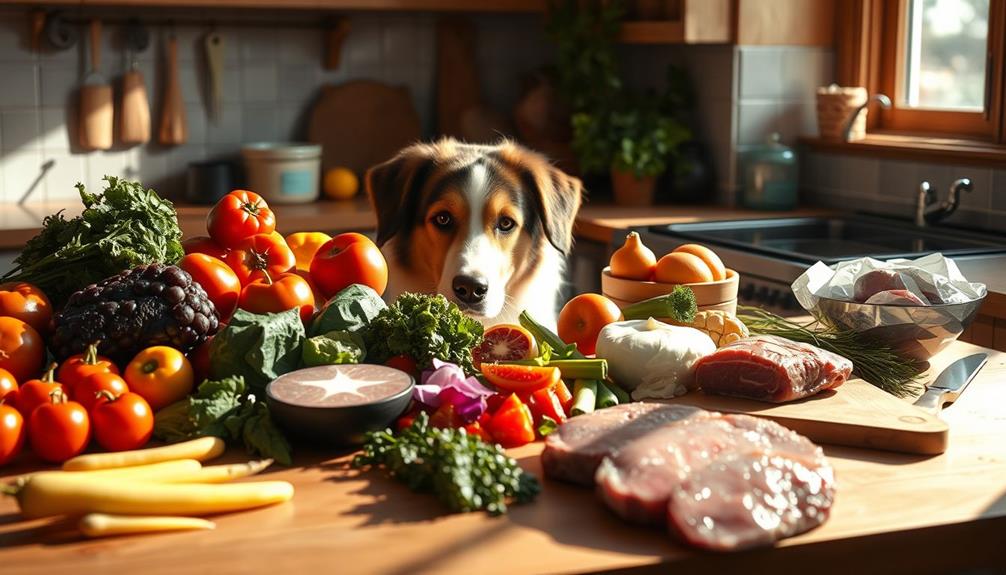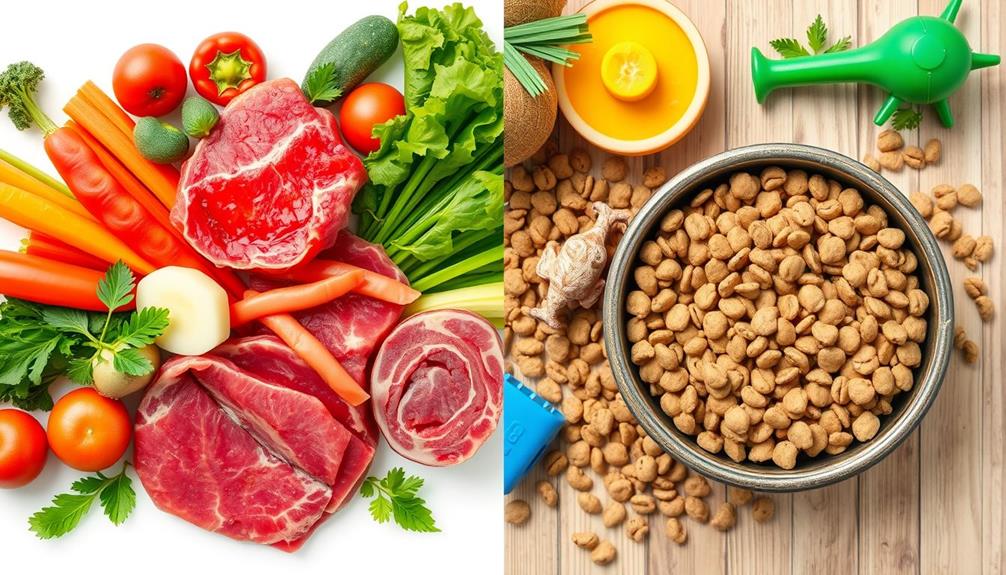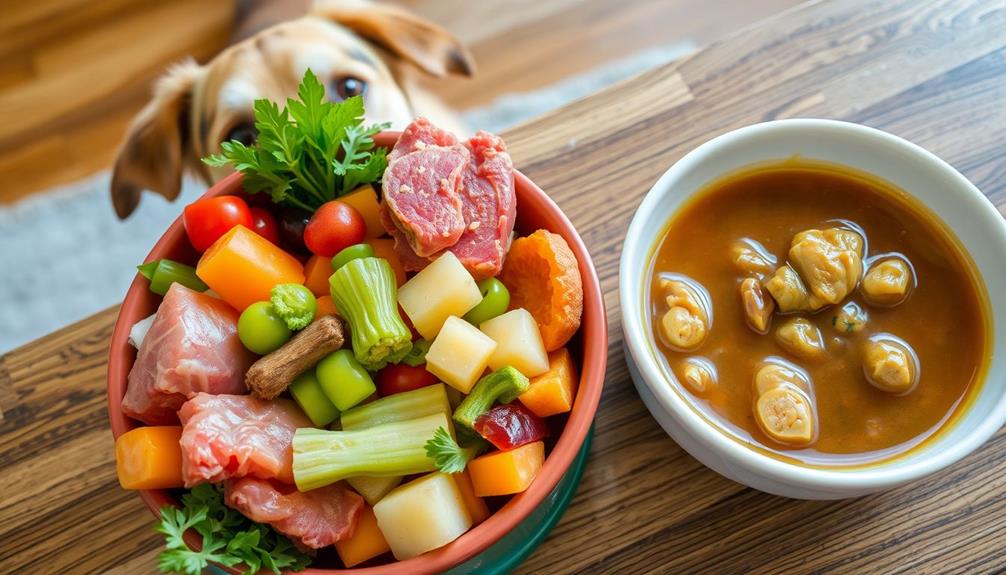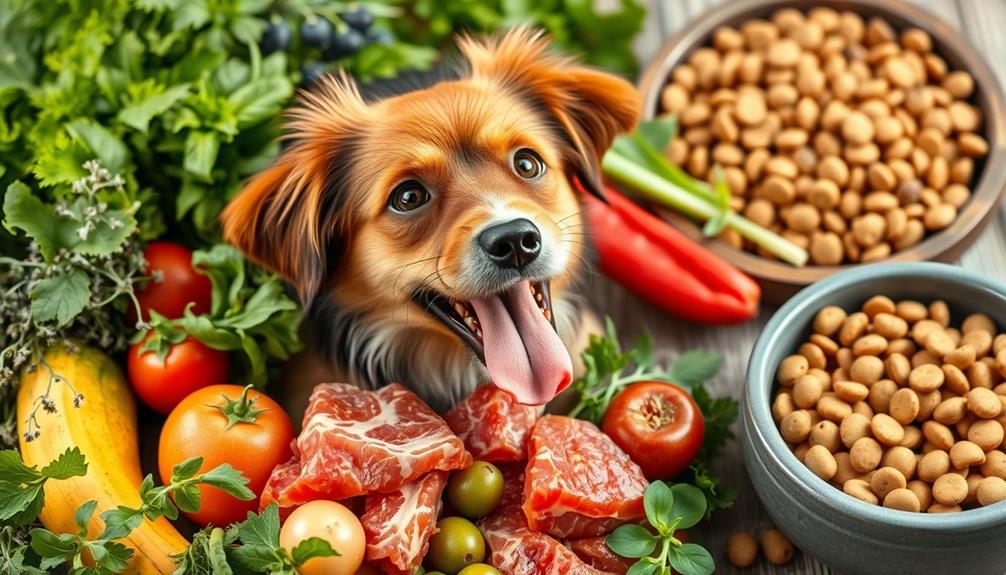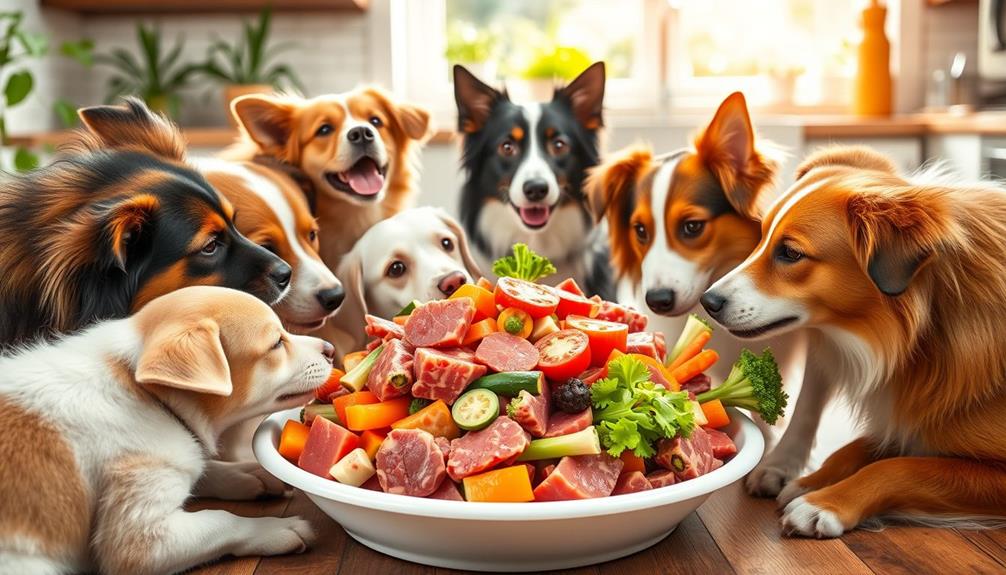Feeding your dog raw food involves offering a balanced mix of uncooked meats, organ meats, bones, fruits, and vegetables. Start by gradually altering their diet—mix 25% raw with 75% current food for the first few days, then adjust to a 50/50 mix, aiming for full raw by day 10. Monitor for any digestive issues during this change. Choose USDA-certified ingredients, include a variety of proteins, and consult your vet for guidance. Make sure to handle food safely and incorporate healthy fats. Keep an eye on your dog's health and behavior for best results, and there's more to explore about your choices. Consulting with a professional about the proper amount of food for a raw feeding dog is essential for their well-being. It’s also important to educate yourself on the nutritional needs of dogs and the potential risks associated with raw feeding. Taking the time to research and understand the benefits and drawbacks of this diet can help you make informed decisions for your pet’s health.
Key Takeaways
- Gradually transition to raw food by mixing it with the current diet, starting with 25% raw for three days.
- Ensure a balanced diet consists of 70-80% raw meaty bones, muscle meat, organ meats, and 10-20% plant matter.
- Choose high-quality, USDA-certified human-grade ingredients to ensure safety and nutritional value.
- Monitor your dog's health, energy levels, and stool quality during the transition to adjust the diet as necessary.
- Consult with a veterinarian experienced in raw feeding to address any concerns and ensure nutritional adequacy.
Understanding Raw Dog Food
When it comes to feeding your dog, understanding raw dog food is essential. A dog's raw diet typically consists of uncooked meat, organ meat, and bones, complemented by fruits and vegetables to align with their natural dietary needs.
To achieve a balanced raw diet, you need to carefully proportion muscle meat, organ meat, and bones to prevent nutritional deficiencies. Companies like We Feed Raw offer pre-formulated options to guarantee your dog's meals are complete and balanced.
Additionally, it's crucial to recognize that certain foods, such as high antioxidant vegetables, can enhance your dog's overall health. You might be surprised to learn that dogs have strong stomach acid and digestive enzymes, allowing them to safely digest raw meat without the need for cooking.
This raw food for dogs mirrors the eating habits of their wild ancestors, promoting overall health through improved digestion and nutrient absorption.
When adapting to raw feeding, do it gradually to avoid digestive upset. The recommended amount typically ranges from 2% to 3% of your dog's ideal body weight daily.
Benefits of a Raw Diet

Feeding your dog a raw diet offers numerous benefits that can greatly enhance their overall health and well-being. One of the key benefits of a raw diet is improved digestion, leading to smaller, firmer stools, which indicate better nutrient absorption.
Many pet owners notice significant improvements in their dog's skin health and coat condition, thanks to the increased moisture and healthy fats found in raw foods. Furthermore, incorporating natural ingredients in your dog's diet can promote overall health and wellness, contributing to a more vibrant life for your pet, especially if they enjoy healthy dog snacks.
Furthermore, raw feeding can assist in weight control by eliminating indigestible carbohydrates commonly found in commercial dog foods. This means your dog can maintain a healthy weight more easily.
Natural dental health is another advantage; chewing on raw bones helps reduce plaque and tartar buildup, promoting better oral hygiene.
You might also observe increased energy levels in your dog, as raw diets provide a more natural diet that aligns with their evolutionary needs. Additionally, many dogs experience a reduction in allergy symptoms, making them more comfortable and active.
Safety and Quality Considerations
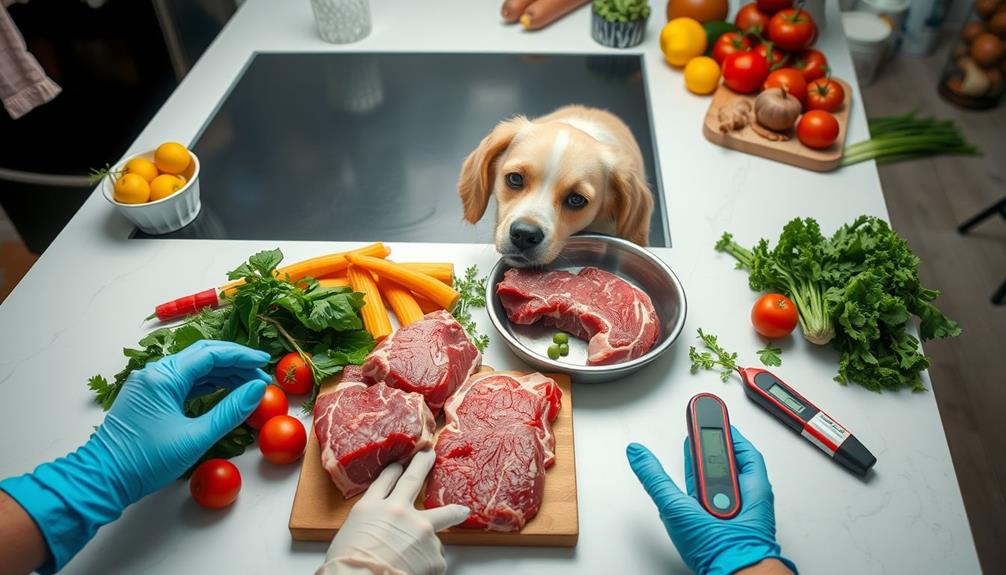
Guaranteeing the safety and quality of raw dog food is vital for your pet's health. Start by selecting USDA-certified human-grade ingredients, which meet high safety standards.
Additionally, consider incorporating safe snacks for dogs, such as vegetables that are non-toxic and beneficial for their diet, to promote overall health safe snacks for hamsters.
Always wash your hands and surfaces thoroughly to prevent bacterial contamination, like Salmonella, that can affect both you and your dog. Utilizing high-pressure processing (HPP) can further enhance food safety by eliminating harmful bacteria without compromising nutritional value.
When choosing meat sources, verify they come from reputable suppliers to avoid contaminated or illegal ingredients that could harm your dog. This is essential for maintaining the quality of the raw diet you provide.
Regular vet check-ups are also important, as they help monitor your dog's health and can detect any potential nutritional deficiencies or allergies early on.
Transitioning to Raw Food
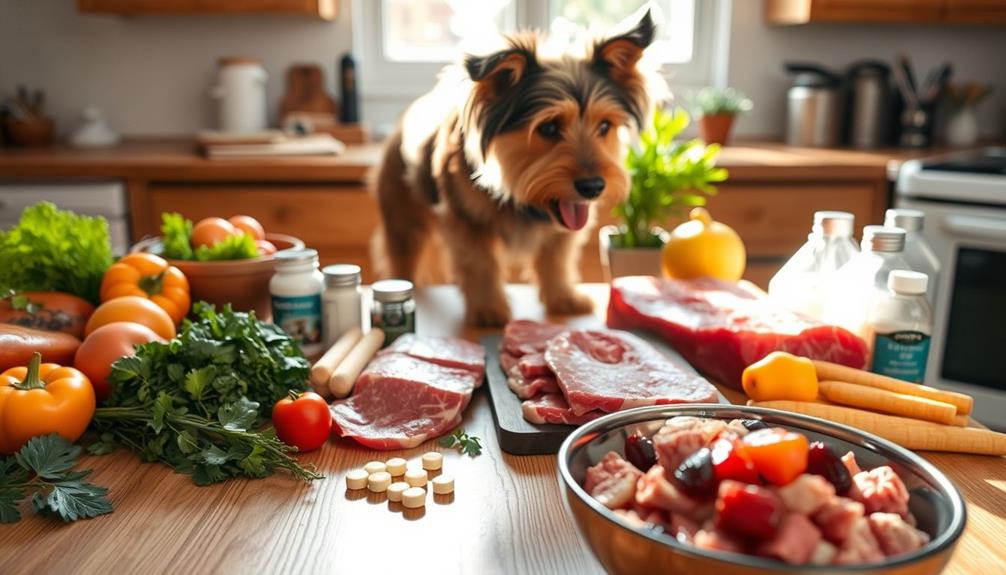
Shifting your dog to a raw food diet can be an exciting journey toward better health. To guarantee a smooth shift, follow these simple steps:
1. Start Slow: For the first three days, mix 25% raw food with 75% old food. This gradual introduction helps your dog's digestive system adjust.
It's also beneficial to research cold medications overview for insights on how dietary changes can affect overall health and wellness.
2. Balance It Out: For the next three days, switch to a 50/50 mix, and then a 75/25 raw-to-old food ratio for another three days.
3. Aim for Completion: By Day 10, you should aim for a complete shift to the raw diet.
During this shift period, it's essential to monitor your dog's health closely. Keep an eye out for any signs of intolerance, like upset stomach or unusual behavior.
If you notice anything concerning, adjust the food ratios accordingly.
Don't hesitate to consult with a veterinarian experienced in raw feeding practices to guarantee your dog's nutritional needs are met.
A successful shift to raw food can lead to improved energy levels, a shinier coat, and overall better well-being for your furry friend.
Choosing Raw Food Options

Once your dog has adjusted to the raw food diet, the next step is selecting the right options for their meals. Look for raw dog foods that are complete and balanced, adhering to AAFCO guidelines. This means they should contain the right proportions of muscle meat, organs, and meaty bones.
Variety is key, so choose options that incorporate multiple protein sources, like beef, chicken, and fish, to guarantee your dog receives essential nutrients. Additionally, consider establishing a budget for your dog's food to maintain financial health while investing in their well-being. This is similar to how a budget helps manage expenses in personal finance.
Prioritize brands that use USDA-certified human-grade ingredients; this assures quality and safety. Always check for transparency regarding the nutritional content of the products. Understanding what goes into your dog's food is vital for their overall health.
Consider using subscription services that deliver raw food directly to your door. These services often allow you to customize meals based on your dog's specific health needs, making it easier to cater to their diet.
Practical Feeding Tips

When switching your dog to a raw food diet, it's essential to change gradually to avoid digestive issues. This method helps their digestive system adapt to the new food, ensuring better nutrient absorption and overall health.
Start with a small percentage of raw food mixed with their current diet and slowly adjust the ratio over ten days.
Additionally, make sure to include a variety of protein sources to keep their nutrition balanced and healthy, as this supports their immune system function due to high vitamin and antioxidant levels found in raw foods high vitamin and antioxidant levels.
Gradual Transition Process
Changing your dog to a raw food diet can be a smooth process if done gradually. Start with a 25% raw food and 75% current diet mix for the first three days. This gradual alteration process helps your dog adjust, much like how trusting instincts can safeguard against emotional pain in relationships.
Then, switch to a 50/50 mix for another three days. After that, increase to 75% raw food and 25% old food for the next three days, aiming for a complete raw diet by Day 10.
During this alteration, it's essential to monitor your dog closely for any signs of digestive upset or allergies. Here are three key things to keep in mind:
- Be patient – Some dogs may take longer to adjust, so don't rush the process.
- Adjust portions – Make sure the raw food is nutritionally balanced and suitable for your dog's size, age, and activity level.
- Check health and weight – Keep an eye on your dog's overall condition to confirm they're thriving on the new diet.
Feeding dogs raw can be rewarding, but it requires attention and care. Enjoy the journey to a healthier, happier pup!
Balanced Nutritional Components
What elements should you prioritize to guarantee your dog's raw food diet is balanced? Start by ensuring your raw diet for dogs includes 70-80% raw meaty bones (RMBs), muscle meat, and organ meats.
Incorporate organ meats, focusing on liver for essential vitamins and heart for taurine, aiming for about 10% and 5% of the diet, respectively. Additionally, incorporating essential oils for health may support your dog's overall well-being.
The remaining 10-20% should consist of plant matter like vegetables and fruits to provide additional nutrients they need.
Incorporate safe RMBs, such as chicken necks or lamb ribs, to meet calcium and phosphorus requirements; adult dogs should have about 10-15% bone content in their diet.
Pay attention to the fat content, keeping it between 10-20% by adding healthy fat sources like fish oil or flaxseed oil. This helps balance omega-3 and omega-6 fatty acids, which are crucial for your dog's health.
Frequently Asked Questions
How to Properly Feed Your Dog Raw Food?
To properly feed your dog raw food, start gradually, ensuring a balanced diet of muscle meat, bones, and organ meats. Monitor their weight and health regularly, adjusting portions as needed for ideal nutrition.
How Do I Feed My Dog Raw Affordably?
Imagine a chef crafting a feast; you can do the same for your dog. Buy ingredients in bulk, seek local deals, and embrace DIY meals. Your pup's health doesn't have to break the bank.
How to Balance a Raw Diet for Dogs?
To balance a raw diet for your dog, mix muscle meat, bones, organ meats, and some plant matter. Adjust fat content and protein sources, ensuring variety, while monitoring your dog's health and weight regularly.
How Many Times a Day Should I Feed My Dog Raw Food?
You won't believe how simple it is! Feed your adult dog raw food once or twice daily, while puppies need three to four meals. Adjust portions based on their size and activity for ideal health.
Conclusion
Feeding your dog raw food might seem complicated, but you'll soon find it's just as simple as tossing a bowl of kibble. After all, who wouldn't want to trade convenience for the chance to prepare fresh meals for their furry friend? Sure, you'll be handling raw meat and balancing nutrients, but isn't that what makes you a devoted pet owner? Embrace the chaos of a raw diet, and your dog might just thank you by being healthier—and messier!


